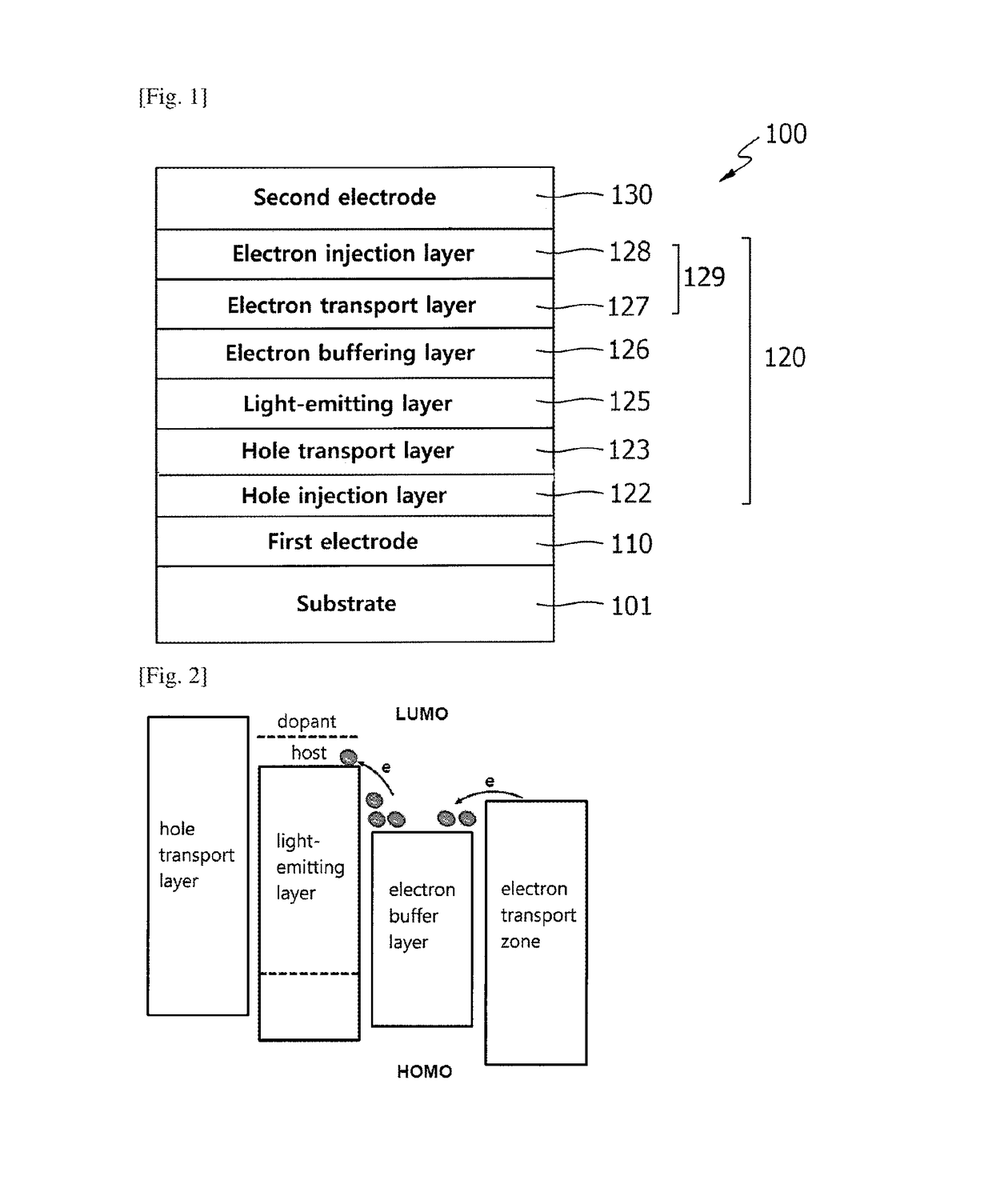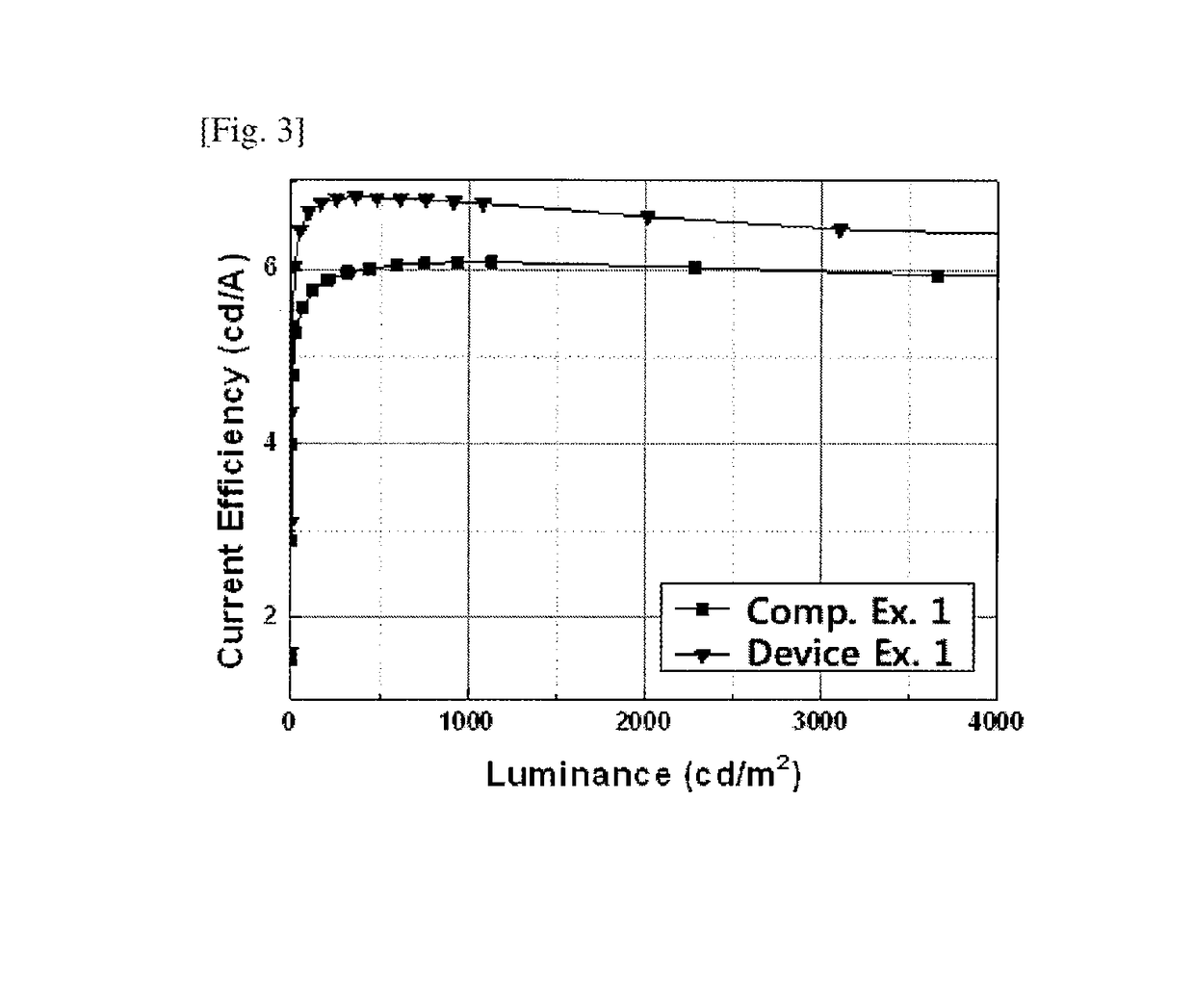Electron buffering material and organic electroluminescent device
- Summary
- Abstract
- Description
- Claims
- Application Information
AI Technical Summary
Benefits of technology
Problems solved by technology
Method used
Image
Examples
example 1
on of Compound B-3
[0059]
[0060]Preparation of Compound 1-1
[0061]After mixing 1-bromo-2-nitrobenzene (39 g, 0.19 mol), dibenzo[b,d]furan-4-yl boronic acid (45 g, 0.21 mol), Pd(PPh3)4 (11.1 g, 0.0096 mol), 2 M K2CO3 aqueous solution 290 mL, EtOH 290 mL, and toluene 580 mL, the reactant mixture was stirred for 4 hours while heated to 120° C. After the reaction is completed, the mixture was washed with distilled water, and extracted with EA. The extracted organic layer was dried with anhydrous MgSO4, and the solvent was removed with a rotary evaporator. The residue was purified by column chromatography to obtain compound 1-1 (47 g, 85%).
[0062]Preparation of Compound 1-2
[0063]After mixing compound 1-1 (47 g, 0.16 mol), triethylphosphite 600 mL, and 1,2-dichlorobenzene 300 mL, the reactant mixture was heated to 150° C. and stirred for 12 hours. After the reaction is completed, unreacted triethylphosphite and 1,2-dichlorobenzene were removed using a distillation apparatus. The remaining mix...
example 2
on of Compound B-10
[0066]
[0067]Preparation of Compound 2-1
[0068]Compound 2-1 (10 g, 32.74 mmol, 74.68%) was obtained by the synthetic method of compound 1-1 using dibenzo[b,d]thiophen-4-yl boronic acid (10 g, 43.84 mmol).
[0069]Preparation of Compound 2-2
[0070]Compound 2-2 (7 g, 25.60 mmol, 78.19%) was obtained by the synthetic method of compound 1-2 using compound 2-1 (10 g, 32.74 mmol).
[0071]Preparation of Compound B-10
[0072]The objective compound B-10 (5.6 g, 40%) was obtained by the synthetic method of compound B-3 using compound 2-2 (7 g, 25.6 mmol) and 2-chloro-4,6-diphenyl-1,3,5-triazine (8.7 g, 32.6 mmol).
example 3
on of Compound B-22
[0073]
[0074]The objective compound B-22 (5.3 g, 49%) was obtained by the synthetic method of compound B-3 using compound 2-2 (7 g, 25.6 mmol) and compound 3-1 (8.2 g, 32.6 mmol).
[0075]Compounds B-1 to B-72 were synthesized by the same method as Examples 1 to 3 above. Specific property data of the representative compounds therefrom are listed in Table 1 as below:
TABLE 1YieldMeltingUVPLMS / EIMSCompound(%)point (° C.)(nm)(nm)(found)325260358471488.5430259336463686.9626350356429581.7746225338482504.3878312344385489.5967249324458610.71040324352482505.71145255334451581.71289275320456580.71372267334459610.71546270344471593.71842288370475745.91928323N / AN / A746.82039320325516581.72138198317461504.62249274322491580.72449284368474669.825232703244567632626245300460656.82752241294464581.72842328343481656.82932294296467655.23134294N / AN / A656.83260280294468593.73446324324495589.73582250356448669.83830293344469669.83923238362429593.74044357322460655.84448278344395580.747482213343966...
PUM
 Login to View More
Login to View More Abstract
Description
Claims
Application Information
 Login to View More
Login to View More - R&D
- Intellectual Property
- Life Sciences
- Materials
- Tech Scout
- Unparalleled Data Quality
- Higher Quality Content
- 60% Fewer Hallucinations
Browse by: Latest US Patents, China's latest patents, Technical Efficacy Thesaurus, Application Domain, Technology Topic, Popular Technical Reports.
© 2025 PatSnap. All rights reserved.Legal|Privacy policy|Modern Slavery Act Transparency Statement|Sitemap|About US| Contact US: help@patsnap.com



